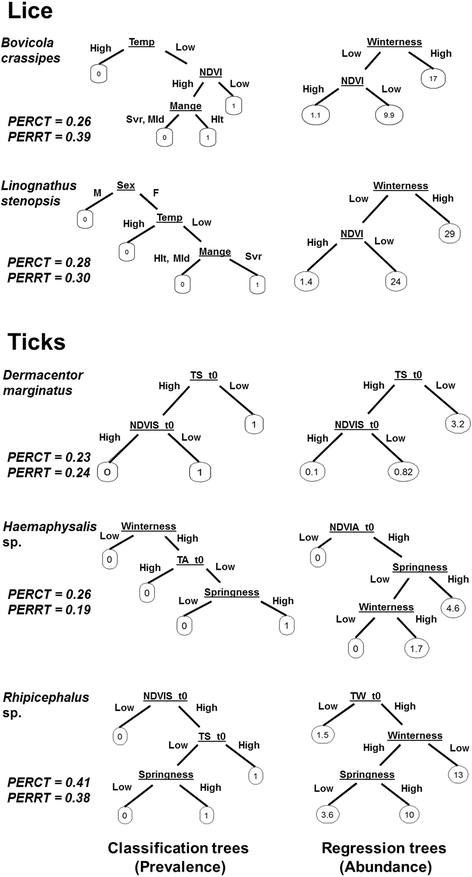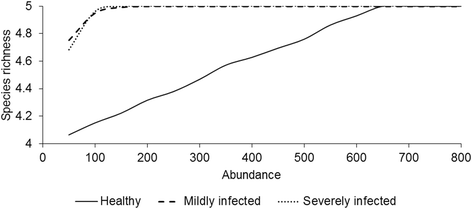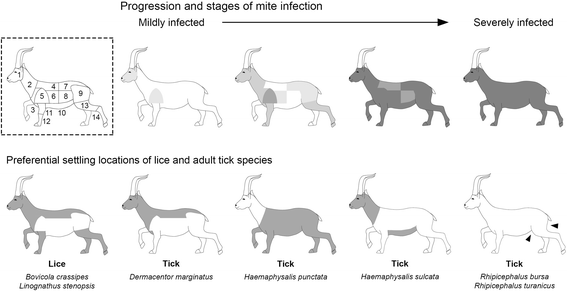Sarcoptes scabiei infestation does not alter the stability of ectoparasite communities
- PMID: 27370780
- PMCID: PMC4930578
- DOI: 10.1186/s13071-016-1659-2
Sarcoptes scabiei infestation does not alter the stability of ectoparasite communities
Abstract
Background: The host represents a heterogeneous ecosystem where multiple parasite species co-occur and interact with each other for space and resources. Although these interactions may rule the features of an infracommunity and may shape the infracommunity response to external perturbations, the resilience of ectoparasite communities to new infestations remains poorly explored.
Methods: We analysed the composition of the ectoparasite communities found on 214 individual Iberian ibexes (Capra pyrenaica) inhabiting the Sierra Nevada Natural Space, southern Spain. Using classification and regression trees, we explored how the presence of Sarcoptes scabiei (a highly contagious mite), the off-host environment and the host sex govern the prevalence and abundance of lice and ticks. Null model analysis was applied to assess the impact of S. scabiei on the structure of the ectoparasite communities.
Results: Our results suggest that S. scabiei infestation acts in tandem with off-host environment and host sex to define the prevalence and abundance of lice and ticks. We also provided evidence for differences in species co-occurrence only at the early stages of S. scabiei infestation. Regarding species diversity, we recorded that ectoparasite communities in scabietic ibexes reached a high richness faster than those in healthy individuals.
Conclusions: Even though we show that ectoparasite burden is correlated with S. scabiei infestation, off-host environment and host sex, the species response to S. scabiei infestation and climate seem to be highly variable and influenced by ectoparasite life-history traits. Ectoparasite communities also appear resilient to perturbations which is in agreement with what was previously reported for endoparasites. Future refinement of sample collection and the incorporation of ecological and epidemiological-related variables may allow us to establish causal effects and deepen the knowledge about the mechanisms and consequences of ectoparasite interactions.
Keywords: Capra pyrenaica; Community ecology; Ecosystem engineer; Multiparasitism; Sarcoptes scabiei.
Figures




Similar articles
-
Co-infection patterns in the ectoparasitic community affecting the Iberian ibex Capra pyrenaica.Parasit Vectors. 2023 May 30;16(1):172. doi: 10.1186/s13071-023-05797-y. Parasit Vectors. 2023. PMID: 37254132 Free PMC article.
-
First report of interspecific transmission of sarcoptic mange from Iberian ibex to wild boar.Parasit Vectors. 2021 Sep 19;14(1):481. doi: 10.1186/s13071-021-04979-w. Parasit Vectors. 2021. PMID: 34538252 Free PMC article.
-
Skin-scale genetic structure of Sarcoptes scabiei populations from individual hosts: empirical evidence from Iberian ibex-derived mites.Parasitol Res. 2008 Dec;104(1):101-5. doi: 10.1007/s00436-008-1165-3. Epub 2008 Aug 30. Parasitol Res. 2008. PMID: 18758821
-
Sarcoptic mange in wombats-A review and future research directions.Transbound Emerg Dis. 2018 Apr;65(2):399-407. doi: 10.1111/tbed.12770. Epub 2017 Nov 18. Transbound Emerg Dis. 2018. PMID: 29150905 Review.
-
Parasites of wombats (family Vombatidae), with a focus on ticks and tick-borne pathogens.Parasitol Res. 2021 Feb;120(2):395-409. doi: 10.1007/s00436-020-07036-0. Epub 2021 Jan 6. Parasitol Res. 2021. PMID: 33409643 Review.
Cited by
-
Co-infection patterns in the ectoparasitic community affecting the Iberian ibex Capra pyrenaica.Parasit Vectors. 2023 May 30;16(1):172. doi: 10.1186/s13071-023-05797-y. Parasit Vectors. 2023. PMID: 37254132 Free PMC article.
-
How sensitive and specific is the visual diagnosis of sarcoptic mange in free-ranging Iberian ibexes?Parasit Vectors. 2019 Aug 15;12(1):405. doi: 10.1186/s13071-019-3665-7. Parasit Vectors. 2019. PMID: 31416471 Free PMC article.
References
Publication types
MeSH terms
LinkOut - more resources
Full Text Sources
Other Literature Sources
Medical

